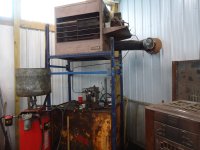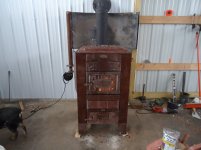I recently put up a 36 x 50 x 12 ft pole barn in western NY. My heat setup has been working very well so far this winter, and it is about as cheap and simple as one could imagine. Rather than trying to heat the whole, uninsulated building, I built a 12 ft wide x 30 ft long loft area in one corner, with an 8 ft ceiling. I put 6" of insulation on the outside wall (steel), and made the inner walls from wood, with 1" chestnut board and batten siding. The loft floor is made from 1" thick chestnut boards, with 5/8" thick OSB on top. Other than the OSB, I salvaged all that lumber, along with hand-hewn posts and beams and sawed framing lumber (used to frame the loft) from an old barn that my great great grandad built on the site in 1883. The area under the loft is split between a 20 x 12 ft woodshop, which has man doors on opposite corners, and a 10 x 12 ft metal shop, which is open to the interior.
The 20' long x 12' wide x 8 ft tall woodshop is all that I heat. I have been using a 20 pound propane bottle with a heater that screws right on top of the bottle. The heater has 3 settings, low, medium, and high. When I want to work out there, I set it on high and it takes about a half hour to raise the temp in the from about 30 to 55. When it gets about 55 (comfortable working temp), I turn it it down to low, and it holds it there quite well. Such a setup probably would not work real well in a tightly sealed building, but my barn is fairly well ventilated. The board and batten siding has many old nail holes in it, and the ceiling ain't all that tight. One of these days, I will bring a CO monitor out of the house and check it out when I have been running the propane heater for a while. If the outside temperature is above 40, it gets too hot in there, even with the heater on low. I just leave it off then and put on long underwear and an insulated flannel shirt. Fuel cost has been minimal. I think they charge $ 8.00 to fill a propane tank on the reservation, and they last quite a while.
This winter has been quite mild so far, as have been most of them over the last few years. Since my heater keeps that woodshop very comfortable, set on low, when the outside temperature is between 25 and 40, I am thinking it would probably be ok if it ever gets below zero again, up on high. It is not looking like we are going to see that this winter.


